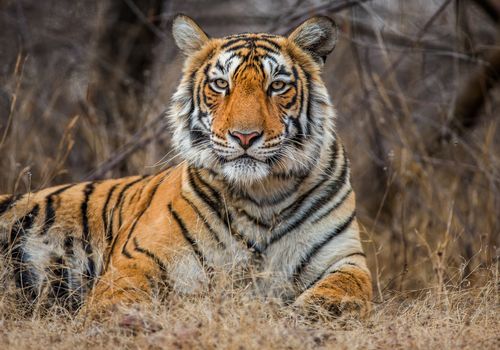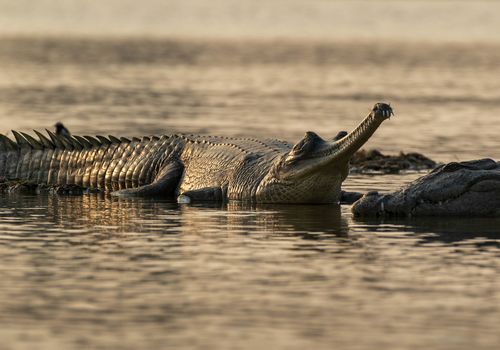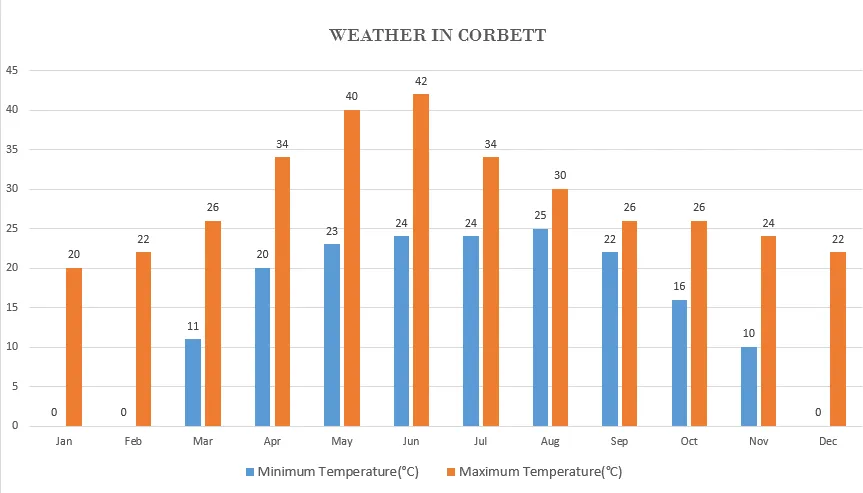Corbett National Park
Uttarakhand, India
About Corbett National Park
Nestled across 520 square kilometers along the serene banks of the Ramganga, Kosi, and Sonanadi rivers, Corbett National Park stands as India’s foremost wildlife sanctuary. Established on August 8, 1936, originally as Hailey National Park, it pays homage to Sir Malcolm Hailey, the then governor of the United Provinces. Later, in 1957, the park was rightfully rechristened Corbett National Park in honor of Jim Corbett. A celebrated figure, Corbett transitioned from a renowned hunter to a fervent naturalist, author, and photographer.
Jim Corbett’s indelible influence shaped the park’s formation and boundary demarcation. Corbett National Park offers more than just a glimpse into India’s rich biodiversity; it provides an unparalleled tiger safari experience. Enthusiasts can immerse themselves in nature safaris, delving into the captivating world of India’s wildlife. For those seeking avian wonders, Corbett National Park serves as a gateway to India’s prolific birdwatching havens. Embark on a journey into the heart of nature, linking the thrill of tiger safaris with the allure of India’s breathtaking landscapes.
Highlights
- Rich avian diversity, over 600 bird species.
- Jim Corbett's legacy, a renowned naturalist and author.
- First Indian national park, established in 1936.
- Diverse ecosystem in the Himalayan foothills.
- Prime raptor habitat with 49 species.
- Stunning landscapes along Ramganga, Kosi, and Sonanadi rivers.
- Ideal for bird-watching and wildlife safaris.
- Tranquil, rejuvenating getaway in India's wilderness
Corbett National Park holds a distinguished place on the global stage as a top-notch bird sanctuary. Amidst the foothills of the majestic Himalayas, it embraces the title of one of the finest bird parks worldwide. Amidst the vast Indian subcontinent, which boasts a staggering 2,060 bird species and subspecies, this park has been graced by over 600 distinct bird species at various times. Notably, this number surpasses the collective count of bird species found in all of Europe, representing a remarkable one-fourth of India’s avian diversity. This park is a true haven for bird enthusiasts, home to an impressive 49 out of the 69 raptor species found in India.
This sprawling reserve, with its 520 square kilometers of unspoiled beauty, is a sanctuary of tranquility and serenity. It offers a captivating and restorative experience, making it an ideal destination for those seeking a rejuvenating vacation. Whether you’re an avid bird-watcher or a nature lover in search of respite, Corbett National Park beckons with its mesmerizing charm and remarkable wildlife.
Facts about Corbett National Park
Area: 1318.54 sq. km- 520.13 sq. km is core and 797.72 sq. km is buffer forest.
Coordinates: 29°32′55″N and 78°56′7″E
Key Species of Corbett National Park

Mammals
- Tiger
- Asiatic Elephant
- Leopard
- Yellow Throated Martens
- Rhesus Macaque
- Gray Langur
- Wild Pig
- Sambar
- Spotted Deer
- Barking Deer

Birds
- Himalayan Rubythroat
- Great Hornbill
- Long Tailed Broadbill
- Chestnut Headed Bee Eater
- Great Barbet
- Kaleej Pheasant
- Brown Dipper
- Blue Tailed Bee Eater
- Pallas’ Fish Eagle
- Lineated Barbet

Reptiles
- Ghariyal
- Mugger Crocodile
- Indian Rock Python
- King Cobra
- Common Krait
- Russell’s Viper
- Indian Cobra
- Burmese Python
- Bengal Monitor Lizard
- Indian Wolf Snake
Safari Zones of Corbett National Park
Each park is categorized into three distinct zones: Core, Buffer, and Reserved. The Core zone serves as a sanctuary for the jungle’s natural state, preserving ecosystems found within the biosphere reserves. Here, the Forest Department enforces strict protection of wildlife and natural resources. The Buffer zone allows for the harmonious coexistence of animals and a portion of the human population. Lastly, the Reserved forest functions as a virtual boundary demarcating the forest’s limits. Despite these divisions, it’s essential to note that animals, being unaware of these “zones,” freely roam throughout their entire forest home.
In the case of Bandhavgarh, it boasts three Core zones: Tala, Maghdi, and Khitauli. Tala, as the oldest zone, is distinguished by its unique attractions, including Bandhavgarh Fort, Badi Gufa, Shesh Shaiya, and Chakradhara Hide. Maghdi and Khitauli, known as Gate no. 2 and Gate no. 3 respectively, offer exceptional Tiger sightings. With Tala witnessing a high volume of tourists, Maghdi and Khitauli provide a refreshing change, offering an entirely different perspective of Bandhavgarh. Tala offers breathtaking landscapes and picturesque views, while Maghdi and Khitauli immerse you in the authentic jungle experience.
Reaching Corbett National Park
Train
The closest Railhead to Corbett National Park is Ramnagar at a mere distance of 15 kms. After reaching Ramnagar, one can drive to the Park.
Flight
The closest air head to Corbett is Dehradun, which is 243 kms from the park. Dehradun is connected with major cities like New Delhi.
Road
Corbett is connected to major cities by road like Agra and New Delhi.
New Delhi: 230 kms, 06 hours by road.
Agra: 300 kms, 08 hours by road.
Weather and Clothing
- DO NOT carry shiny/bright colored clothing. Instead, carry earthy colors like shades of dull green or olive green, beige, and grey. Black is also avoidable as it attracts mosquitos.
- Carry comfortable, breathable clothes (cotton) in summer.
- Carry layers (4-5) of thin woolen clothes rather than one heavy jacket for winter. Layers are a lot more helpful through the varying temperatures during the day.
- Carry a wind cheater/rain coat just in case there is a light shower.
- Carry a Cap/Hat during summer.
- Avoid wearing strong perfume while on safari. Animals have a strong sense of smell and it may distract them.

Enquire Now
Please fill the form below and our team will get back to you within 24 hours with a perfect tiger safari tour package.
FAQ
Jim Corbett National Park, one of India’s premier national parks, is situated in the northern state of Uttarakhand. Nestled in the foothills of the Himalayas, this wildlife sanctuary spans 520 square kilometers and is renowned for its rich biodiversity, making it a sought-after destination for nature enthusiasts and wildlife lovers. The park was initially established in 1936 as Hailey National Park, but it was later renamed in honor of the legendary hunter and naturalist, Jim Corbett, who played a crucial role in its creation and boundary demarcation.
Jim Corbett National Park is celebrated for its diverse and vibrant wildlife. It’s especially famous for its population of Bengal tigers, making it a prime destination for tiger safaris in India. Apart from tigers, the park is home to various other mammals such as leopards, elephants, deer, sloth bears, and langurs. The park also houses a wide array of bird species, with over 600 species documented, adding to its allure as a birdwatching haven.
Experiencing a tiger safari in Corbett National Park is a thrilling adventure. The park offers several options for tiger safaris, including jeep safaris and canter safaris. These safaris are conducted by trained naturalists and guides who are well-versed in the park’s terrain and wildlife. Visitors can explore different zones within the park, each with its own unique wildlife and landscapes. The park’s proximity to the Kosi and Ramganga rivers makes it an ideal habitat for tigers, increasing the chances of a tiger sighting during a safari.
The ideal time for a tiger safari in Corbett National Park is from November to June. During this period, the weather is pleasant, and the chances of spotting tigers are relatively higher. The park remains closed during the monsoon season, from July to October, to ensure the safety of both wildlife and visitors. Therefore, planning your visit between November and June allows you to make the most of your tiger safari experience.
Yes, visitors can stay within the park at various forest rest houses, government-run lodges, and private resorts. These accommodations offer a range of options, from budget-friendly to luxury, ensuring a comfortable stay in the heart of the wilderness. Staying within the park allows guests to immerse themselves in the natural surroundings and enjoy early morning and evening safaris for the best wildlife viewing opportunities.
Yes, there are specific guidelines and regulations in place to ensure the safety of both visitors and wildlife during tiger safaris. These include maintaining a safe distance from the animals, following designated routes, and refraining from littering. Visitors are also advised to respect the park’s rules, including the prohibition of loud noises and disturbances that could disrupt the natural habitat. Additionally, it’s essential to listen to the instructions of the experienced guides and naturalists accompanying safari groups.
Yes, the park is divided into different zones, each with its unique characteristics and wildlife experiences. Popular zones include Dhikala, Bijrani, Jhirna, and Dhela. Dhikala is well-known for its open grasslands and an excellent chance to spot tigers and elephants. Bijrani is renowned for its diverse flora and fauna, making it a paradise for birdwatchers. Jhirna is ideal for wildlife enthusiasts looking to spot leopards and sloth bears. Dhela is known for its lush greenery and diverse wildlife, offering a tranquil safari experience.
Absolutely, besides tiger safaris, Corbett National Park offers a plethora of activities. Nature walks, birdwatching, and photography are popular options for those interested in the park’s diverse flora and fauna. Additionally, the park’s proximity to the Ramganga and Kosi rivers allows for angling and fishing opportunities. Visitors can also explore the Corbett Museum to learn about Jim Corbett’s life and conservation efforts, adding an educational element to their visit.
Yes, Corbett National Park is actively engaged in wildlife conservation. It plays a pivotal role in the preservation of Bengal tigers and their habitats. The park also focuses on the protection of other endangered species and their ecosystems. Conservation initiatives involve research, anti-poaching measures, and community involvement to promote sustainable coexistence with wildlife. Visitors contribute to these efforts through park entry fees, which are directed toward conservation activities.
Jim Corbett National Park stands out as a unique national park in India due to its historical significance, rich biodiversity, and the legacy of Jim Corbett himself. Its role in tiger conservation and its diverse landscapes, from dense forests to riverbanks, provide a multifaceted wildlife experience. With the opportunity for tiger safaris and a vast avian population, Corbett National Park offers a well-rounded and unforgettable wildlife adventure, making it a must-visit destination for nature enthusiasts and wildlife lovers in India.



